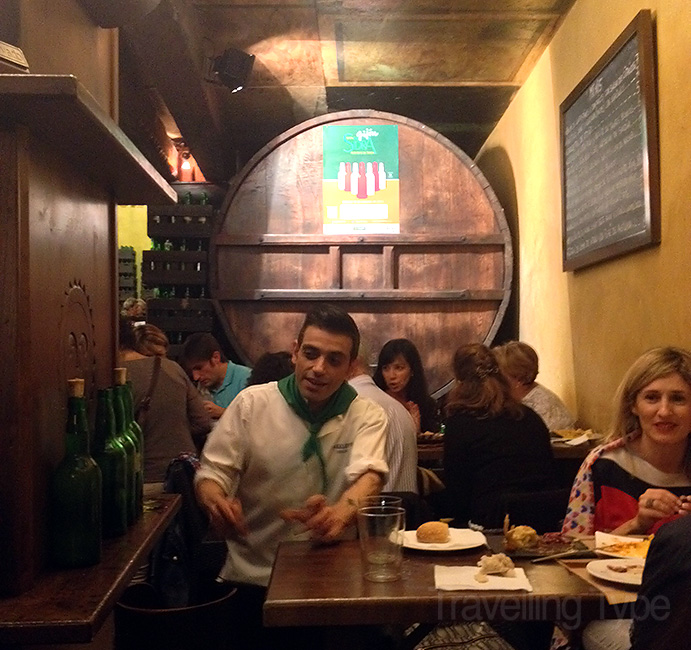I stepped from the taxi onto slabs of wet pavement that continued down the street, right to my hotel door. Then the smell wafted across the laneway, past the convivial tables that coloured this Friday afternoon in Oviedo, northern Spain. It was like apples and vinegar and maybe even a hint of leather and a dash of farmyard. It seemed to me the strangest thing. Then I realised what was going on.
A waiter approached a table, thrust one arm high above his head, the other near his knee, then began pouring a lofty cascade of apple cider into a glass, spilling a third of it onto the floor. This was my introduction to Spanish cider in the principality of Asturias, where it’s as much a passion as it is a way of life. Thirty minutes later and I was enjoying my first bottle.
Asturian Spanish cider house rules
I was a little apprehensive at first. In Australia, where I’m from, cider is sweet and not something I’m particularly fond of. However here it tastes entirely different and the way it’s consumed makes it much more fun.
Asturian cider is naturally fermented with apples and no added sugar, which is why it’s so flat. So the idea behind such a conspicuous cascade is aeration, as the flavours and aromas of cider are released when it’s bubbly. This is why only enough to be taken in one gulp (two fingers worth, or un culin) is poured at a time. Generally, the cider has around a six percent alcohol content, so you can down a few without too much concern.
Cider houses in Asturias are called sidrerias and many of them are littered with sawdust, which helps mop up the excess that gets sprayed on the floor. While I’ve poured my own cider before, it’s not as easy as it looks. Firstly, cider glasses must be thin in order to oxidise the cider sufficiently. Then, the glass must be tilted at an angle so the cider hits the side before it fills up, otherwise it won’t get sufficiently disturbed.
When the cider is poured, it must be consumed immediately to maximise flavours and aromas. It’s also tradition to leave a small amount in the glass, which is then poured out. This is in order to clean the glass, as glasses are traditionally shared when drinking from one bottle. You then wait until the waiter returns and pours you another glass. Waiters are busy splashing cider into glasses and onto the floor for hours on end on a busy night.
While I didn’t share my glass, I thoroughly enjoyed the novelty of the whole procedure, as you can see in the video above. This was taken at Sidreria El Gato Negro in Oviedo, one of my favourite places in Asturias to eat and drink. After spending a month in Oviedo, I lived in a larger Asturian town further north called Gijón where I frequented cider houses such as La Galana and the popular local chain Tierra Astur.
Cider capital of the world
Both Asturias and the Basque region are famous for their cider, although Asturias produces roughly 80% of Spain’s cider and consumes more per capita than any region in the world. And as Asturias is isolated from the rest of Spain by the Picos de Europa mountain range, elements of a unique culture – stemming from the Celts, Romans and Christians – have been preserved.
Celtic Asturians were recorded drinking cider by Roman settlers around the 1st century BC. However, it wasn’t until the early 1900s that Asturian cider production took off. Some 100 years later, quite inadvertently, I had my first cider just metres from Calle Gascona in Oviedo, a street which allegedly has more sidrerias than any other in the world.
So how does Asturian Spanish cider taste? On the whole I enjoyed it. It’s a little sour, quite vinegary, crisp and I will honestly say that I found the pouring tradition more novel than anything else, as I really didn’t find it carbonated the cider that much. More than likely I failed to appreciate the finesse of Asturian cider culture. I often snuck a flat pour when waiting for a waiter to return. In Asturias, that’s heresy!
Have you tried cider in Asturias or any other part of Spain? What did you think of it?





Hi Andy, great take in the sidra natural culture. I travelled and lived through Spain for a few years around 2008 to 2011, in and around Castilla y Leon. I got hooked on having a crisp, cold cider with lunch every day and it’s something I’ve missed in my life since I’ve returned to Australia. Any ideas on where to find it here? For sure the climate would be equally suitable.
Thanks Scott.
Sounds like a great journey you had! I never got around that way unfortunately. I’m missing the cider a bit too and haven’t found any in OZ yet. I haven’t looked very hard, although I’m not sure we have the culture for it?
Hi Scott, we always found it so hard to get good cider in Oz too! so we decided to hunt down real cider apples and we started our own cider company, only making dry cider with character. We just soft launched. If you’re interested to find out about our cider, email me… todd(at)barrelandhatch(dot)com